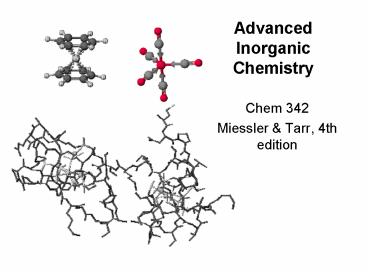Advanced Inorganic Chemistry - PowerPoint PPT Presentation
Title:
Advanced Inorganic Chemistry
Description:
Title: Chemistry 109 Author: Susan M. Young Last modified by: Bill2 Document presentation format: Custom Other titles: Times ProN W3 ... – PowerPoint PPT presentation
Number of Views:732
Avg rating:3.0/5.0
Title: Advanced Inorganic Chemistry
1
Advanced Inorganic Chemistry
- Chem 342
- Miessler Tarr, 4th edition
2
Syllabus
- Goals Objectives
- Textbook (bring to class)
- Attendance Grading2 take-home exams final
(55)homework (15)literature presentation
(10)literature exam (15)participation (5)
3
Course Content
- Chapters 1-5 (bonding theories)Chapter 6,
Acid-Base Donor-Acceptor TheoryChapters 9, 10,
12 (coordination chemistry) - Chapter 11, Coord Chem Electronic Spectra
Chapters 13, 14 (organometallic
chemistry)Chapter 16, Bioinorganic
Environmental Chem - Experimental Methods in Inorganic Chemistry
- Nanochemistry noncovalent interactions
4
Chapter 1 - Intro to Inorganic
- What is it?
- Sub-fieldsmain-group, coordination chemistry,
organometallic, bioinorganic, physical inorganic,
heavy-metals, trans-uranium.. - How does it compare to Organic Chemistry?
- Compounds with single, double, triple bonds
- Inorganic compounds can contain quadruple bonds
(sigma pi pi delta bond)Cl4ReReCl42 - Carbon maximum number of connections 4
- Inorganic carbon is found in carbon cluster
compounds, in bridging alkyl groups
5
Chapter 1 - Intro to Inorganic
- Organic H is a terminal atom, only bonds to one
other element. Inorganic The same rules do not
apply. Lewis structure of B2H6? - Organic Limited geometries (linear, trigonal
planar, tetrahedral, bent). Inorganic Also
square planar, trigonal bipyramid, octahedral,
and more - Inorganic also has aromatic compounds (borazine
B3N3H6)
6
(No Transcript)
7
(No Transcript)
8
(No Transcript)
9
(No Transcript)
10
(No Transcript)
11
History of Inorganic Chemistry
- Ancient times through Alchemy
- Descriptive chemistry, techniques, minerals (Cu
compounds), glasses, glazes, gunpowder - 17th Century
- Mineral acids (HCl, HNO3, H2SO4), salts and their
reactions, acid and bases - Quantitative work became important, molar mass,
gases, volumes - 1869 The periodic table
- Late 1800s Chemical Industry
- Isolate, refine, purify metals and compounds
- 1896 Discovery of Radioactivity
- Atomic structure, quantum mechanics, nuclear
chemistry (through early 20th century)
12
History of Inorganic Chemistry
- 20th Century
- Coordination chemistry, organometallic chemistry
- WWII Military projects Manhattan project, jet
fuels (boron compounds) - 1950s
- Crystal field theory, ligand field theory,
molecular orbital theory - 1955
- Organometallic catalysis of organic reaction
(polymerization of ethylene) - Modern Issues
- Bioinorganic chemistry (nitrogen fixation),
modeling biochemical process, enzymes, x-ray
crystallography, - nanochemistry, manipulation of noncovalent
interactions
13
Take a Look
- Literature taken from Inorganic Chemistry
- Take a quick lookWhat are the sub-fields?What
do you recognize, understand?What looks foreign?































